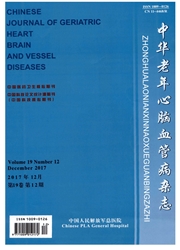

 中文摘要:
中文摘要:
目的探讨椎基底动脉系统短暂性脑缺血发作(TIA)患者后循环脑组织的动态CT灌注成像方法研究的应用价值。方法对24例临床诊断为椎动脉粥样硬化狭窄所致的椎基底动脉系统TIA的患者行数字减影血管造影术(DSA)和后循环脑组织的动态CT灌注成像等检查。测定局部脑血流量(rCBF),局部脑血容量(rCBV),平均通过时间(MTT)和造影剂达峰时间(TTP)定量数据,并根据影像学表现进行脑梗死前期分期。结果入选者DSA显示椎动脉中、重度狭窄率为60%~100%,头颅CT平扫均未发现与临床症状相对应的病灶,而CT脑灌注成像有13例患者发现与临床症状相对应的低灌注区。共检出16个低灌注区,其中2例患者整个后循环供血区较同层面前循环供血区TTP明显延迟,1例双侧小脑半球可见2个局部低灌注区。16个低灌注区进行脑梗死前期的分期,Ⅰ2期:15个,Ⅱ1期:1个。结论后循环脑组织CT灌注成像技术可以辅助定性及定量评估椎基底动脉TIA患者是否处于脑梗死前期,并根据定量分析了解后循环供血脑组织的病理生理学状态。
 英文摘要:
英文摘要:
Objective To evaluate the usefuless of dynamic perfusion CT in the evaluation of pa tients with vertebral basilar artery transient ischemia attack (TIA). Methods DSA and dynamic perfusion CT of posterior circulation were performed in 24 patients with vertebral basilar artery TIA diagnosed by neuroscience physicians. There were 17 men and 7 women with mean age of 59.4(41 to 74) years. Perfusion CT was used to calculate CBF,CBV,MTT and TTP in TTP delayed areas and corresponding areas of the opposite side. The pre-infarction stages were determined by the ratios of involved areas to non-involved corresponding areas. Results DSA confirmed vertebral artery stenosis(60%-100%). Focus was not found by CT imaging in areas corresponding to their clinical symptoms in all 24 patients. Sixteen hypoperfusion lesions were found in 13 patients. These hypoperfusion areas corresponded to their clinical symptoms. The delayed TTP was found in the territories of bilateral vertebrobasilar arteries of 2 patients. Two regional hypoperfusion areas were found in bilateral cerebellar hemispheres of 1 patient. According to the ratio of hypoperfusion areas to normal areas, 15 of the 16 hypoperfusion areas were in stage Ⅰ 2 and 1 in stage Ⅱ 1. Conclusions CT perfusion imaging of posterion circulation can help to assess whether the basilar artery TIA patients are in the pre-infarction stage and to provide useful pathophysiological information for the further clinical therapy.
 同期刊论文项目
同期刊论文项目
 同项目期刊论文
同项目期刊论文
 期刊信息
期刊信息
